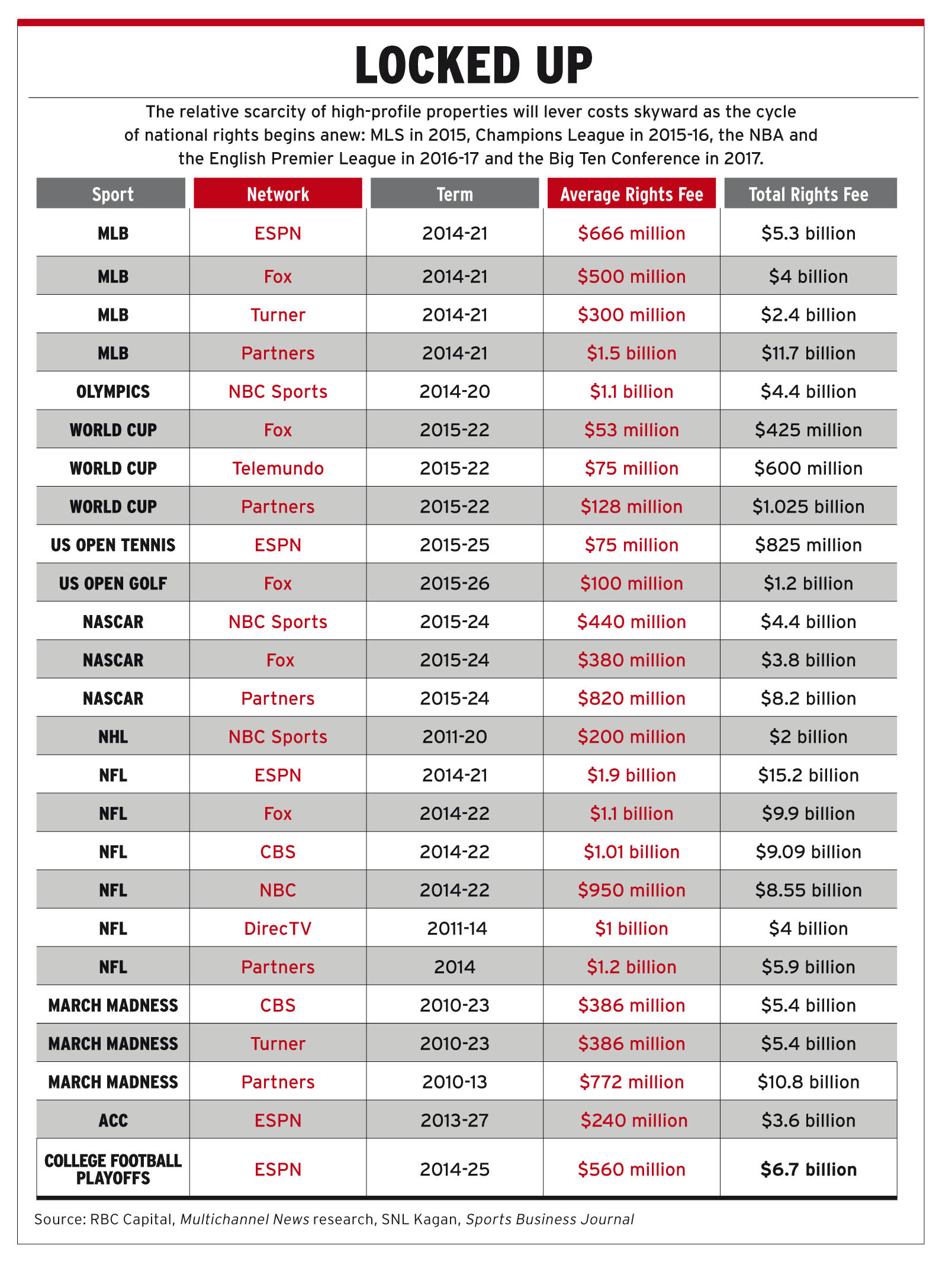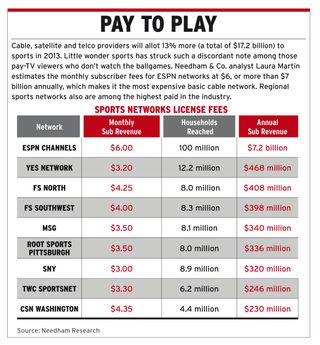Game Theory

Who says TV sports aren’t getting more expensive? NASCAR just put the finishing touches on $8.2 billion in rights deals covering the 2015 through 2022 stock-car seasons, concluding a second pact with Fox and bringing NBC Sports Group into its pit row, with ESPN and TNT putting the brakes on their relationships.
Meanwhile, Fox Sports shook up golf’s TV-network establishment, holing a 12-year deal with the United States Golf Association for the U.S. Open. The deal, which tees off in 2015, is worth a reported $100 million annually—more than double the combined $37 million NBC Sports and ESPN have been allocating.
Escalating sports costs have been the white-hot issue for consumers carping about bills and calling for à la carte carriage of cable networks. Why should they have to pay for national and regional sports networks that they don’t watch?
It is the bane of TV distributors who doggedly fight sports network increases. And it is the largest and most telling indicator of the health of the pro leagues.
The cost of sports is part of the rhetoric in the retransmission-consent dispute between CBS and Time Warner Cable, with the broadcaster citing the MSO’s multibillion-dollar deals for regional sports networks, anchored by the National Basketball Association’s Los Angeles Lakers and their neighbors, Major League Baseball’s Dodgers. And some media analysts say that CBS and TWC may not settle their retransmission- consent dispute until the National Football League kicks off next month.
Needham & Co. analyst Laura Martin has predicted that if the cry to unbundle were heeded and ESPN put on a tier, a lot of value would evaporate. The resulting ESPN “super fan homes” would have to purchase a suite of sports programming at much higher rates for the company to maintain its revenue levels, and the pay-television industry could lose as much as $13 billion because many customers would, in turn, punt on their entertainment packages.
Meanwhile, the market is ripe with opportunity for those with a big enough checkbook. That’s because for all the talk about soaring costs, sports is a unique product. Sports programming is DVR-proof for fans— 97% of sports viewing occurred live in 2012, according to Nielsen.
The opportunity to expand revenue is at the heart of Fox’s Aug. 17 launch of national sports service Fox Sports 1, which is being converted from Speed, and Fox Sports 2, from Fuel. Fox Sports Media Group copresidents Eric Shanks and Randy Freer said they expect Fox Sports 1 will be profitable by 2016.
Thus as summer turns to fall, the following is a scorecard for TV sports, a fall preview of what viewers can expect from programmers in college and pro sports, the costs involved and the winners and losers.
COLLEGE FOOTBALL
Continuing its recent game plan, ESPN will open the season with a blitz of 42 games across linear, regional and digital vehicles from Aug. 29 through Sept. 2.
“A couple of years back, we really decided to plant a flag on Labor Day weekend with high-profile games on multiplatforms,” said Burke Magnus, ESPN senior VP of college sports programming.
Last season, ABC, ESPN and ESPN2 combined to reach more than 187 million viewers, with those services and ESPNU averaging nearly 2.02 million watchers for 216 regular-season games. ABC’s Saturday-night primetime series set the pace, scoring 6.52 million viewers on average.
Showcasing Big 12, Pac-12 and Conference USA contests, Fox outlets will televise 100 national games across the broadcast network, Fox Sports 1, FSN and Fox College channels, plus another 50 contests on various regional sports networks. FX, whose ratings fell 40% as contests were shifted to Fox broadcast, is now on the sidelines.
Fox Sports 1 jumps into the fray right away, with Utah-Utah State on opening night Aug. 29 and Kansas State-North Dakota State on Aug. 30. Typically, Fox Sports 1 will air a Thursday primetime contest and Fox College Saturday, the two-hour pregame show hosted by former ESPNer Erin Andrews, will lead into either a doubleheader or tripleheader.
Fox broadcasts begin on Sept. 7 with West Virginia-Oklahoma in the first of five successive Saturday primetime games, with the network’s coverage culminating with the Big Ten championship game on Dec. 7 and the AT&T Cotton Bowl on Jan. 3.
CBS has the top overall package—6.17 million viewers for 13 telecasts last year (down 10% from 2011)—with the Southeastern Conference, whose members have captured the last seven national titles.
Scheduled to air 16 SEC contests, including the conference championship, CBS also has the highest-profile early-season game—provided Heisman Trophy winner Johnny “Football” Manziel’s eligibility has not been compromised— when Texas A&M hosts two-time defending champion Alabama on Sept. 14.
CBS Sports Network, with 50 million subscribers, has added more Mountain West action and will televise 51 contests from the MWC, Conference USA and service academies, up from 44 in the 2012 campaign.
The Big Ten Network starts its seventh season with a record slate of 47 games, up from 42 in 2012, including 12 in primetime. Over the first four weeks, the network, now counting 52 million subs, will feature Big Ten teams and opponents from the SEC, Pac-12 and Atlantic Coast Conference. With its launch on Comcast in late June/July, TV Everywhere service BTN2Go has scored almost complete distribution with its carriers.
NBC hit Nielsen pay dirt with Notre Dame’s unexpected run to the national championship game, tackling a 67% jump to 4.38 million viewers over seven telecasts in 2012. Seven games also are on the slate for 2013, highlighted by ND’s Sept. 28 matchup with Oklahoma and primetime contests versus Arizona State and USC on Oct. 5 and 19, respectively.
NBC Sports Network will offer 11 Colonial Athletic Association and Ivy League contests, highlighted by a tripleheader on Oct. 12 and doubleheaders on Nov. 9 and Nov. 23.
In its sophomore season, Pac-12 Networks will air 35 conference home games. The network recently inked a deal with Google Fiber for its main service and its six sub regionals and secured a rollout with Comcast’s Sports Entertainment Package in the Midwest.
NATIONAL FOOTBALL LEAGUE
The NFL’s TV partners are getting set to kick off their final season of their current rights contracts, under which ESPN, Fox, CBS and NBC will pay a combined $3 billion in 2013. Next season, the rights fees will jump to just under $5 billion.
With the exception of NFL Network, which rode expanded distribution and an increased slate to 13 games from eight in prior seasons to a record average audience of 7.3 million per contest, the league’s ratings were down in 2012. That included the playoffs, which saw some game windows drop by double digits. Even the Super Bowl reported a drop in audience for the first time in seven years, although it still averaged 108.4 million viewers, making it the third-most-watched television program in U.S. history.
Despite the decreases, pro football’s Nielsens are to die for. NBC’s Sunday Night Football was the most-watched show in all of television for a second consecutive season, averaging 21.4 million viewers and an 8.2 rating in the 18 to 49 demo, off from 21.5 million and an 8.4 in the 2011 season. NBC kicks off the season on Sept. 5 with a rematch of last year’s playoff battle between the Super Bowl champion Baltimore Ravens and the Denver Broncos.
On cable, ESPN’s Monday Night Football reigned as the medium’s top show for a seventh straight year, averaging 12.8 million viewers and a 5.1 in the 18-49 demo, down 3% and 6% respectively from 2011. Per usual, the network opens with a doubleheader: a big-market battle between coach Chip Kelly’s Philadelphia Eagles and the returning quarterback Robert Griffin III’s Washington Redskins, followed by Houston-San Diego on Sept. 9.

Other potential key games: Chicago- Green Bay on Nov. 4, Washington-San Francisco Nov. 25 and Dallas-Chicago on Dec. 9. CBS, wielding its smaller-market AFC package, averaged 17.7 million viewers, a 4% decline from 18.4 million from in 2011. This season, CBS, which will be flanked by a new four-hour NFL pregame show on CBS Sports Network, should benefit from a Manning brothers matchup in week two, as Peyton and the Denver Broncos take on Eli and his New York Giants at MetLife Stadium on Sept. 15.
Speaking of the New Jersey venue, it’s the site of a possibly snowy Super Bowl XLVIII next Feb. 2. Earlier this month, during Twenty- First Century Fox’s investor day, Fox Sports Group copresident and chief operating officer Eric Shanks said that ad sales for the title game were “progressing quite well.”
Fox, which is welcoming SNY’s Kevin Burkhardt to its play-by-play roster this year, averaged 19.8 million viewers and a 7 rating among the 18-49 set during the 2012 regular season, down 1% and 4%, respectively.
NFL RedZone, the league’s companion channel that provides whip-around coverage of every game on Sundays, will debut a new set this year, including a video wall that will allow for host Scott Hanson to provide new and faster ways to present all the action.
The league will also offer a redesigned version of its official mobile app from Verizon Wireless, which will now be available on all major platforms.
DirecTV has launched a “most powerful NFL” ad campaign for its NFL Sunday Ticket out-ofmarket package. The satellite TV leader is discussing a renewal with the league under which it may or may not retain Sunday Ticket exclusivity.
Click here to read the full story.
Broadcasting & Cable Newsletter
The smarter way to stay on top of broadcasting and cable industry. Sign up below










